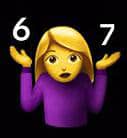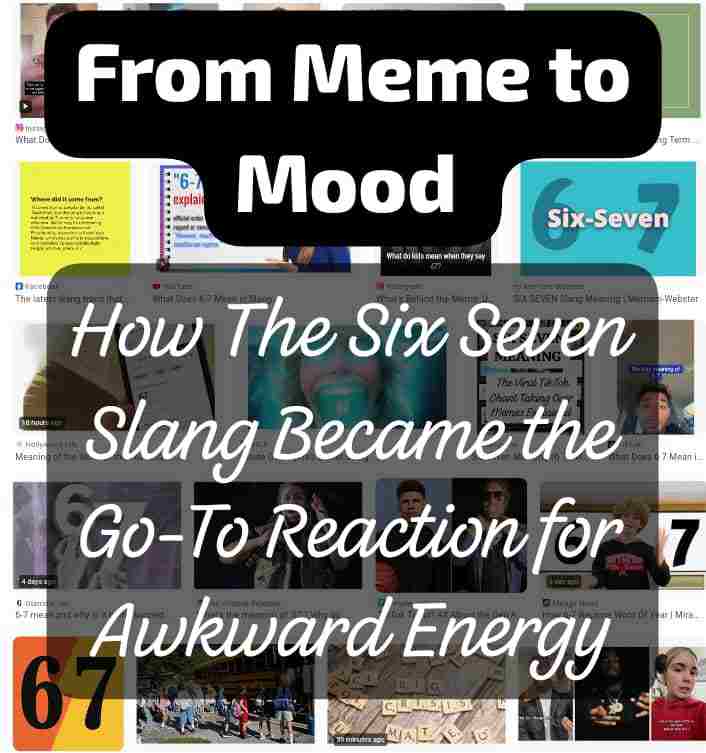Six Seven is a two tiny words that somehow said a whole lot. I saw it popped up on TikTok not long ago. Since then I’ve been watching the phrase move from comment threads into captions, text messages, and even T-shirts.
In short: what began as a meme-sized reaction has quietly become a mood marker. In this post I’ll explain how that shift happened, why “six seven” works so well, and what it tells us about how slang grows online.
If you want the full background, see my deep dive here: six seven meaning in slang, and if you’re curious about real-world reactions, I documented a week-long experiment using the phrase here: I used the slang phrase for a week – See what i documented.
Table of Contents
6-7 moved from a quick joke to a shared signal

One unique thing I noticed about Meme language is that it’s built for speed. A short clip, a punchy caption, or a repeatable sound can turn into a tiny code that lots of people use.
And six seven fits that pattern perfectly: it’s short, visually neat (6-7), and flexible in tone. When enough people use the same shorthand or catchphrases in the same places, it stops being just a joke and begins to function like a shared signal; a fast way to say, “this is awkward, weird, or mildly sus” without needing a full sentence.
That transition, from isolated joke to social shorthand, depends on repetition and recognizability. People don’t adopt a phrase because it’s clever alone; they adopt it because it helps them belong to a moment.
Once a handful of TikTok creators (majorly) use something repeatedly in captions and reaction videos, fans follow. Before you know it, the slang phrase shows up everywhere and new users treat it as part of the platform’s common language.
Why ambiguity makes six seven powerful and trend-full
One of the reasons six seven slang spread so fast is ambiguity. The phrase doesn’t tell you exactly how to feel; it only points you toward a mood. That vagueness is an advantage online.
A comment like “6-7” can be used alongside a laughing clip, a confused face (😕, or a deadpan caption and still feel right. That versatility makes it easy to drop into lots of contexts.
Ambiguity also invites participation. When people don’t have to pick one narrow meaning, they’re more likely to reuse the phrase and put their own spin on it.
That’s part of meme psychology: the most repeatable elements are those that can carry multiple tones while keeping a recognizable core.
Read More: 6 7 is not the only viral slang this year, check out other TikTok popular viral slangs of 2025
The role of performativity and social proof in Six Seven Spread
Slang thrives on performativity: meaning people use it in part to show they’re “in” on something. When influencers and popular creators started dropping “six seven” into captions and comments, others copied it because it signaled cultural fluency.
Social proof matters: if high-reach accounts use a slang phrase and their audiences echo it, the phrase looks like a norm and spreads faster.
This is why I say context is everything. In my week-long test of using “six seven” in different spaces, the phrase landed perfectly among peers and meme-savvy followers but failed or needed translation in mixed-age or formal groups.
When the social environment shares the meme frame, the shorthand works. When the environment doesn’t, it’s confusing.
6 7 Visuals, emojis, and tone markers

One small but important detail: people often pair “six seven” with emojis or punctuation to nudge the tone. A 😬 or 🤨 makes the comment clearly about awkwardness; a 😂 turns it playful.

These tiny signals reduce misreading. Because “six seven” is short, it lacks the emotional scaffolding longer replies have. Emojis and simple punctuation give that scaffolding back.
Designers, merch makers, and social editors have also leaned into the phrase because it’s visually tidy. “6-7” reads well on T-shirts and thumbnails, which helps it spread beyond comments into everyday culture.
That visibility reinforces the mood: the phrase moves from text to identity, wearing the slogan signals an appreciation for a certain kind of internet humor.
When the shorthand flops
Not every context welcomes a compact reaction. When someone is vulnerable or dealing with something serious, “six seven” can sound dismissive. That’s a risk of any minimal slang: the shorter the signal, the less nuance it carries.
My experiment showed that in emotional or mixed audience spaces, people asked for clarification or reacted negatively. That’s normal and easy to avoid, just don’t use meme shorthand where a sincere, full response is needed.
Another failure mode is overuse. A phrase that appears everywhere can quickly become dead or hollow. Slang lifecycles are short: a term can be fresh and funny one month and banal the next.
The phrases that stick are those that adapt or become shorthand for broader cultural moments.
Why lexicographers are watching
Linguists and dictionary editors track phrases like “six seven” because they show real-time language change. Merriam-Webster and other reference sites monitor usage patterns to see which items are stable enough to define.
Slang isn’t random noise; it’s a living lab for how people compress meaning and negotiate tone in public spaces. For a primer on how slang gets recorded in dictionaries, a reliable place to start is Merriam-Webster’s discussion of slang and usage: https://www.merriam-webster.com/dictionary/slang.
Practical advice for using “six seven” slang.
If you want to use the phrase without stumbling, here are simple, tested rules I follow:
- Match your audience. Use it with people who live in the same meme world.
- Add a tone nudge. An emoji or short follow-up sentence helps avoid being misread.
- Keep it light. Use as a caption or quick reaction, not as a response to someone’s serious problem.
- Rotate your language. Don’t rely on one phrase all the time, variety keeps your tone genuine.
Final thought: a mood, not a meaning
Meme to mood is the right way to think about “six seven.” It’s less a fixed definition and more a shorthand for a shared feeling. That’s why it spread: it gives people a fast, low-effort way to join in on an emotional stance.
As an expert who watches this stuff closely, I think “six seven” is a great example of how modern slang evolves; small, flexible, and entirely social.

